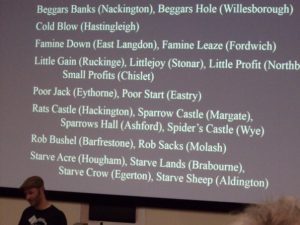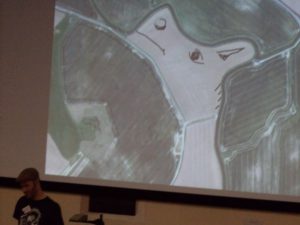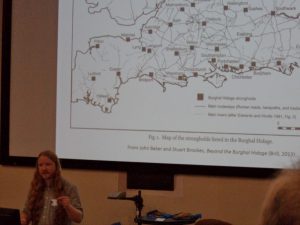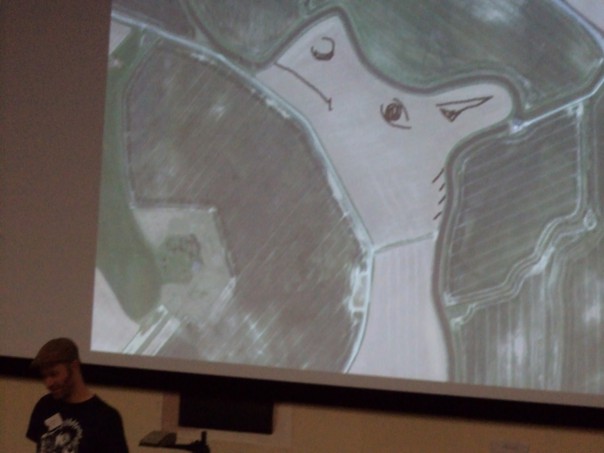This has been an excellent week in terms of lectures and conferences. On Wednesday evening, the second of the Canterbury Historical and Archaeological Society’s winter programme of lectures took place when Dr Doreen Rosman gave a fascinating talk about Elizabeth Barton, the Holy Maid of Kent. As Doreen explained, Barton was one of a number of religious women who gained fame, or notoriety depending on your viewpoint, in late medieval England. Although some were soon discredited because their claims were found to be false, Barton posed considerable difficulties for Henry VIII as he sought to resolve the issue of a male heir. Her chastising of the king for seeking to divorce Katherine of Aragon in order to marry Anne Boleyn and thus legitimise the hoped for male child could realistically only end one way – with her death on the scaffold. Doreen painted some compelling word pictures of this young woman’s grisly end, as well as offering some interesting insights regarding what may have motivated her and how we need to consider her in the context of early 16th-century perceptions without superimposing twenty-first century ideas onto her society.
Keeping with the interplay of Reformation religion and politics, I managed to attend a little of the Shakespeare, Kent and Early Modern Drama conference at the University of Kent on Thursday. There were a number of interesting papers but I’ll only mention one. Dr Andy Kesson, formerly of Kent and now at Roehampton, provided some fascinating ideas about the early theatre and its playwrights, especially the role of Canterbury as the place where several were educated. He also highlighted the issue that even though we don’t have any of Stephen Gosson’s plays, we do know that he was an early playwright and that the lack of play texts should not detract from his place in the developments that were taking place in the early decades of Elizabeth’s reign. He also drew attention to John Bale and how more attention should be paid to this prolific, polemical writer, again with particular reference to his Canterbury connections both in the late 1530s and in the early years of Elizabeth. Such research is important, not least because the proliferation of play texts by more than one author is growing and Canterbury men may feature more heavily than has been thought in the past. In addition, this new research has also brought Shakespeare into Kent because scholars now believed he was responsible for writing certain acts within ‘Arden of Faversham’.

Keeping with this Kentish connection, today I joined over eighty people at the Kent Places and People Names conference at Canterbury Christ Church. This joint venture between the Centre for Kent History and Heritage and the Place Names committee of Kent Archaeological Society featured two talks by Dr Paul Cullen. His first on Kent field names took his audience along the paths and by-ways of Kent as he looked at the tithe map of Crundale, for example, and its Marriage Wood, Marriage Field and Marriage Shave that involves Marriage (Marrege in the 13th century), from Old English mǣre ‘boundary’ + hrycg ‘ridge’ (Kentish hrecg). Paul also looked at a swine pasture in the parish of Swalecliffe and how names can help us to understand just how extensive these north Kent woods were in the Middle Ages. By looking at the names Cæthærst 946 [13th] S:518; Chetherste, Cheterste, Chetterste 13th; Chetherst c.1300, 14th, c.1405 derived from British *kaito- ‘a forest, a wood’ (+ OE hyrst ‘a wooded hill’) he sought to convince his audience that Jetties 1837, a detached part of Swalecliffe, comes from the same root. He then mapped such names across north Kent showing how they stretched from near Rochester almost to the Wantsum Channel. Another aspect of field names Paul discussed was the link to poor or unattractive places and even more intriguing the idea of how shape played a part and his final slide of the Horse Head in Ebony was a great touch – even if as he said it looks more like a donkey!

Paul was followed by Dr Mike Bintley, senior lecturer in English Literature at Canterbury Christ Church, who looked at the use of wic and burh in Old English poetry. To begin Mike explained to his audience the flexibility of the term wic in Old English and that it is linked to the notion of dairy, salt, a riverine or coastal settlement often temporary or seasonal and the idea of trade or a market place. In contrast, the burhs were seemingly defended and defendable places, that is a stronghold with a large population that was identified as a town. Mike then looked at a number of extracts from poems such as ‘The Whale’, ‘The Ruin’, ‘Andreas’ and the post-Conquest poem in Old English ‘Durham’ that is linked to St Cuthbert. As he showed, the earlier poets broadly saw burhs as former Roman towns that had become or were in the process of becoming rundown, and, as a further development of this idea, that regeneration would come through the advent of Christianity. In some ways ‘Durham’ takes this even further, as he explained, where the natural and man-made come together in a symbiotic relationship, a new sense of urbanity that draws on Anglo-Norman ideas to create a new linguistic setting.

The final talk before lunch was given by Dr Harry Parkin, who like Paul works for the Family Names of the United Kingdom Research Project at the University of the West of England. Harry explored bynames and surnames from the Cotswolds to show how his study of fourteenth-century names from the poll taxes and those from baptismal and muster records from the late sixteenth and early seventeenth centuries can offer ideas about regional characteristics and change over time. As he noted, there has been a move away from county-wide studies of such names and instead regional topography is seen as a more significant criterion. In particular, he explored the incidence of the name Shepherd as an occupational name and then as a surname. Such a model may indeed be useful for Kent and it will be interesting to see if anyone takes up the challenge.
After lunch there were a further two talks. The first by Liz Finn, an archivist in the Kent Archives Service, concentrated on her work as the Manorial Documents Register Project officer. She highlighted the differences between Kentish manors and those of the classic open fields of the Midlands before turning to the various types of record found for Kent manors. These are extensive, ranging from court rolls to surveys to terriers to custumals and her search for such documents will take her to London (The National Archives, Lambeth Palace and the British Library) to the Oxford and Cambridge colleges, and even perhaps to Hatfield House. Among the rents she has noted for holdings in the manor of Preston next Faversham are those that mention the usual eggs, hens, some sheep and lambs, and somewhat differently a curlew and a couple of mallards. This index will be extremely useful and once complete The National Archives, Kew will act as host.
The final talk saw Paul return to wear his other hat as a people name specialist. This was a fascinating guide to the development of a number of Kentish surnames, many of which derived in one way or another from German roots. However his final example: variations on Cradduck showed that you should never jump to easy conclusions because this derives from a Welsh personal name. Such examples certainly provided the audience with much to think about and the question and answer session during the last thirty minutes drew a large response. Indeed, this could have gone on longer if time had allowed and once the conference ended there was a queue of people wanting to talk to Paul, while others sought out Liz and Mike. Thus ended a very successful day and Dr Mark Bateson should be thanked for organising it, as should Professor Jackie Eales for offering to co-host the event through the Centre.
 Centre for Kent History and Heritage
Centre for Kent History and Heritage Sheila Sweetinburgh
Sheila Sweetinburgh 877
877


